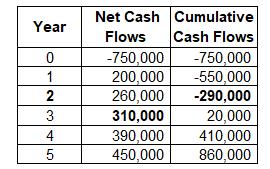How is the Payback Period Utilized for Capital Budgeting?

The payback period is one of the methods used for capital budgeting. It is a straightforward approach to analyze if to pursue a project or not. The payback period shows how long the initial investment will be recovered using the net cash flows. Given the same return, the shorter the payback period, the better option for investment, while a more extended payback period is less desirable given its riskier nature. The payback period is ideal in analyzing risk for a particular project.
On the downside, some factors are not taken into account due to the payback period method's simplistic approach. This method does not take the time value money, which means that the dollar today has more value than the dollar in the future, given the opportunity cost earned by today's invested dollar. Another is the disregard of the cash flows after the payback period, which shows that a project with higher cash flows in the earlier years would become more favorable without considering if the earnings become lesser in the future.
Payback Period Formula in Excel
There are two ways of computing the payback period formula in Excel: computation for even and uneven cash flows. The even cash flow formula is more straightforward than the uneven cash flows. Let's check the two formulas below.
a. Even Cash Flows
Payback Period = Initial Investment
Net Cash Flow
Example A:
Let's say that the project required investment cost is $850,000, with an annual return of $250,000 for the next ten years.
Payback Period = $850,000
250,000
Payback Period = 3.4 years
It takes 3.4 years for the business to recover the investment cost.
b. Uneven Cash Flows
It is easier to compute the payback period formula in Excel of the uneven cash flows. For the given example, the initial investment is $750,000 and the net cash flows for the next five years are $200,000, $260,000, $310,000, $390,000, and $450,000, respectively. In the computation below, the investment can be recovered for more than two years. By dividing $290,000 (the last negative cumulative value) by $310,000 (the net cash flow where the investment is recovered), the fraction of the year can be derived, which is 0.94. It means that the investment of $750,000 can be recovered after 2.94 years or almost three years.
As one of the capital budgeting approaches, the payback period method is a valuable tool to assess risks among the investment options. Given a similar return, the project with a shorter payback period is more favorable. However, this method only considers net cash flows until the investment's recovery, and profitability is not considered. It is best to utilize the payback period approach with other financial metrics such as the discounted cash flow (DCF) and the internal rate of return (IRR), which consider the time value of money.
There are widely available financial model templates online that incorporate the payback period and other financial metrics. eFinancialModels offers these templates to assist you in preparing the financial model before you decide on which project to pursue.
On the downside, some factors are not taken into account due to the payback period method's simplistic approach. This method does not take the time value money, which means that the dollar today has more value than the dollar in the future, given the opportunity cost earned by today's invested dollar. Another is the disregard of the cash flows after the payback period, which shows that a project with higher cash flows in the earlier years would become more favorable without considering if the earnings become lesser in the future.
Payback Period Formula in Excel
There are two ways of computing the payback period formula in Excel: computation for even and uneven cash flows. The even cash flow formula is more straightforward than the uneven cash flows. Let's check the two formulas below.
a. Even Cash Flows
Payback Period = Initial Investment
Net Cash Flow
Example A:
Let's say that the project required investment cost is $850,000, with an annual return of $250,000 for the next ten years.
Payback Period = $850,000
250,000
Payback Period = 3.4 years
It takes 3.4 years for the business to recover the investment cost.
b. Uneven Cash Flows
It is easier to compute the payback period formula in Excel of the uneven cash flows. For the given example, the initial investment is $750,000 and the net cash flows for the next five years are $200,000, $260,000, $310,000, $390,000, and $450,000, respectively. In the computation below, the investment can be recovered for more than two years. By dividing $290,000 (the last negative cumulative value) by $310,000 (the net cash flow where the investment is recovered), the fraction of the year can be derived, which is 0.94. It means that the investment of $750,000 can be recovered after 2.94 years or almost three years.
As one of the capital budgeting approaches, the payback period method is a valuable tool to assess risks among the investment options. Given a similar return, the project with a shorter payback period is more favorable. However, this method only considers net cash flows until the investment's recovery, and profitability is not considered. It is best to utilize the payback period approach with other financial metrics such as the discounted cash flow (DCF) and the internal rate of return (IRR), which consider the time value of money.
There are widely available financial model templates online that incorporate the payback period and other financial metrics. eFinancialModels offers these templates to assist you in preparing the financial model before you decide on which project to pursue.
Advertise on APSense
This advertising space is available.
Post Your Ad Here
Post Your Ad Here
Comments